When it comes to selecting the right cart lifter, there is no one-size-fits-all approach. Evaluating and finding the right equipment is the first but essential step to a successful launch.
By James Rimsa
Enter the world of refuse collection and you may find yourself setting up shop in a new territory and the gear you select at start-up will become the deciding factor in your success. When it comes to selecting the right cart lifter, there is no one-size-fits-all approach. There is a wide variety of technology to choose from, and it can be difficult to know what is best for your needs. In this article, we will focus on choosing the right cart lifter for the job, proper installation techniques and maintaining your fleet of lifters to maximize their lifespan. Finding the right equipment is the first but essential step to a successful launch.
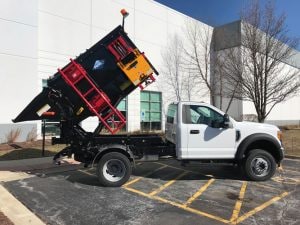
Important First Considerations
To select the right lifter, the first consideration is the carts you will be lifting. Are you lifting existing carts, or will you be placing your own carts? Placing your own carts has the advantage of maintaining uniformity, and branding your service to the community. If collecting existing carts, you may be facing a mixture of cart types, including store-bought carts that may not be compatible with standard lifters.
What type of community is this? Is the community layout suitable for automated collection? Wide streets and open areas common to suburban and rural communities are ideal for automated collection, while urban territories are typically better suited for traditional semi-automated processes. Remember if you are going automated, the carts need to be automated compatible (ANSI Type G). Many store-bought carts are soft and flimsy, they may not stand up to automated grabber arms.
Automated Collection
Automated front-loaders are one of the better choices, if your carts and community is suitable for automated collection. The front-loader trucks have some of the highest compaction rates, collection times are fast, and the it is a one-worker job so labor rates are lower. All the lifting takes place in direct view of the driver/operator, so the operator can keep their eyes on the road ahead and not rely on mirrors or camera systems. One advantage of automated front-loaders is the ability to dismount the can and use the same vehicle for commercial routes. This makes the truck more versatile, and many operators will run residential routes the first half of the week and commercial routes at the end of the week with the same vehicle.
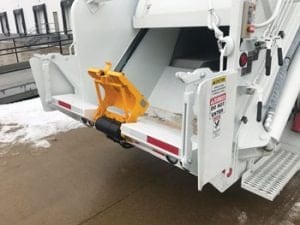
Semi-Automated Collection
If your territory is suitable for semi-automated collection, there are many lifter choices. The three main truck types for semi-automated collection are rear-loader, front-loader, and side-loader, and a variety of lifters are available in each category. Each have their respective advantages and purposes.
Rear-Loaders
Rear-load trucks are very common. They typically have the advantage of being able to service both residential and commercial routes with the same vehicle. They have easy-access hoppers for throwing in bags and other items easily. They can even take bulk items like couches and break them up, so they are a good choice for a take-all vehicle. The disadvantage is they require two or three person teams, with one or two workers at the back and sides of the vehicle. Unfortunately, this exposes the workers to the risk of passing traffic. A few workers are killed or injured every year, which has led to the creation of several safety programs designed to reduce these incidents.
When rear-loaders are used exclusively for residential collection, installation is faster. In many cases, the lifter can be mounted directly to the rear bumper with minimal cutting and just some reinforcement. However, on vehicles that are also servicing commercial containers, it is necessary to notch the sill of the truck deeply and mount the lifters within the notch so that the commercial containers do not roll on top of or contact the lifters. Depending on how the vehicle comes, it may be necessary to add a sill extension over the original sill in order to protect the lifters from contact with the commercial bins. If a sill extension is added, the trunnion-locking mechanism (sometimes called an elephant ear) needs to be extended as well.
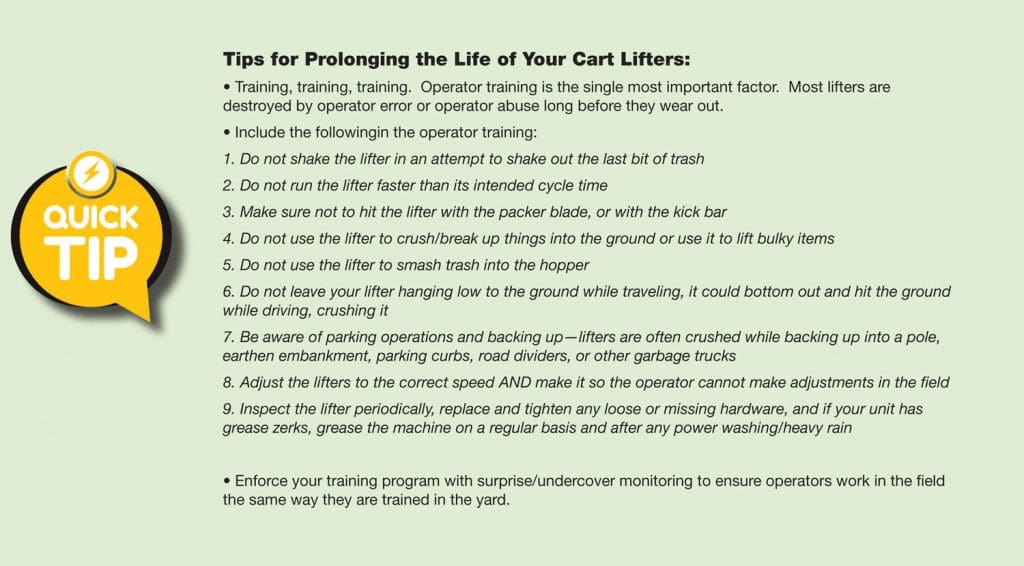
Rear-loader trucks that also service commercial bins typically use a winch or kick bar. (In some circles the kick-bar may be referred to as the tipper-bar). The kick bar is a device that pushes smaller rear-load containers up and dumps them into the hopper faster than a winch. When mounting a cart lifter on a rear-loader, one of the first considerations is to check and see if the truck is equipped with a kick-bar. If it is, it is necessary to choose a cart lifter which is also kick-bar compatible. These special lifters have been designed with a high ground clearance, so that the kick bar can swing freely under them. However, the trade-off for this ability is these types of cart lifters usually do not dump very high or deep. Kick bar compatible lifters usually have some type of sliding mechanism on the lower half that allows the lifter to collapse into a smaller envelope. This structure adds complexity to the lifter design (aka more moving parts to maintain). When choosing a kick bar compatible lifter, look for one that has a slide design that is as maintenance-free as possible. Some sliding designs incorporate self-lubricated plastics, which do not jam up and do not require much grease, if any. These designs are usually the most trouble-free for this type of application.
For rear-loaders without a kick bar, you will want a lifter that dumps as high and deep into the hopper as possible, without hitting the packer blade. Dumping high and deep allows the trash to fall out of the cart completely on the first dump. This also helps the operator dump more carts into the hopper before having to stop and run the packer blade. Since rear-loaders are also typically used for hand loading and bulky items, you will want a lifter that does not interfere with access to the hopper. Look for rear load lifters that store out of the way, under the hopper sill when not in use. Modern lifter designs use self-lubricating bearings and oil-infused plastics, such that not much greasing is needed. Usually you will want to reduce the amount of steel that contacts your plastic bins. Steel parts can scratch the cart and make it weaker over time. Select lifters with plastic hooks and latches, to reduce the wear on your carts.
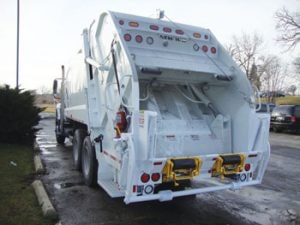
Side-Loaders
For side-loader trucks, the cart lifting operations typically happen on the curbside. This is generally safer for the operator, where they will be exposed to less traffic than a rear-loader vehicle. Side-loaders are usually a two-person operation, although operating with only one worker is possible since the lifting action is closer to the cab. The hopper area is typically smaller, and higher up. Bulky items are generally not collected with a side-loader due to the smaller hopper size. Additionally, side-loaders are usually limited to residential service only, since they cannot engage and lift traditional commercial bins.
Cart lifters on side-loaders are very straightforward. There is no need to worry about a sill extension. There is very little cutting or modifying. The main concern is getting a cart lifter that will dump at the right height. Side-loaders typically come with one or two access doors. In order to increase the size of the hopper and not risk spillage, operators will usually open the top door, but expect the lifter to dump over the lower, shorter door. In some cases, it may be necessary to slot the door to allow the lifter to clear it. The lifters are typically designed to be relatively narrow, so that road width restrictions are not a concern.
Front-Loaders
For front-loaders, a lifter would typically be mounted to a carry can. However, another option exists where a lifter is mounted to the cross bar of the forks. In this scenario, the whole fork assembly must go up and down to dump one cart. This is good for an emergency/special case scenario, but not very productive if you have many carts to dump. Most front-loaders would therefore be mounted to a carry can. Typically, they are mounted curbside or to the leading edge of the carry can. The option to corner-mount the lifter is also available. Most carry cans are ordered with the lifter already mounted, so installation onto the can is limited to only certain aftermarket situations. Front-loaders can be one or two person operations, and the operator is generally a bit safer compared to a rear-loader. Carry cans are capable of taking much of the same materials as rear-loaders, as the can is typically about 4 cubic yards in capacity. This allows for most bulk items to be tossed in easily. Since the waste goes into the top of the vehicle, there is no waiting for the packer to cycle, and the compaction rate of front-loaders and volume capacity are both high. The downside is overhead restrictions, such as electric wires and tree branches. For this reason, the operator must exercise additional caution when dumping the carry can.
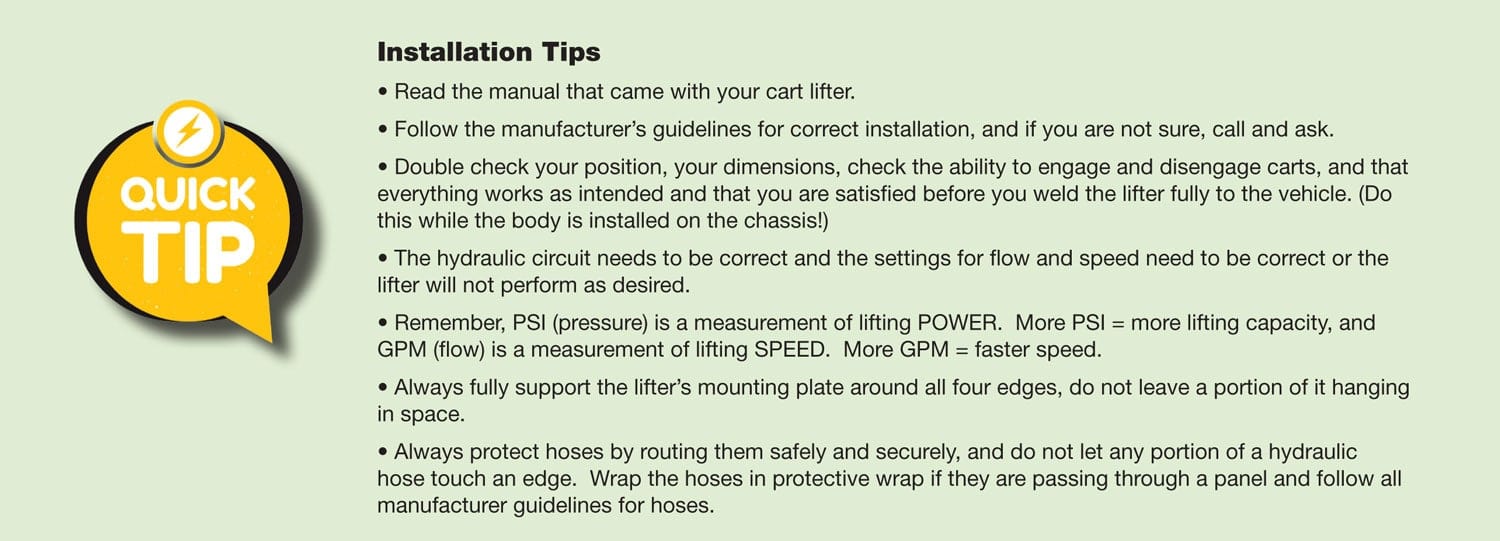
Lifter Care and Maintenance
When it comes to lifter care and maintenance, remember that most modern cart lifters have very little to adjust because they have been designed to be as maintenance-free as possible. The main thing any fleet would benefit from is having a daily inspection performed on the equipment prior to leaving the yard for the day. Run the unit up and down once and make sure it moves normally. During this inspection, look for any missing or loose hardware, or anything obviously broken and replace it before heading out on the route. Maintenance managers should periodically check cycle times with a stop-watch to make sure the lifters are operating within the standard 3-4 seconds up and 3-4 seconds down. The maximum pressure settings should be adjusted to not exceed the pressure recommended in the manual, to limit weight lifting ability to 400 lbs. Any grease points, especially slides, should be greased especially right after a power washing or heavy rain. Train all new employees on how to use the equipment and check on them from time to time to make sure they are following the guidelines while in the field. Remember, your cart lifter manufacturer wants you to be happy with their product. Call them if you have any problems or concerns and they will be happy to help. Do this, and certainly your cart lifter program will be successful. | WA
James Rimsa is Engineering Manager for Perkins Manufacturing (Bolingbrook, IL). He has been with Perkins since 1994 and is the holder of several waste-industry patents. For more information, visit www.perkinsmfg.com.
